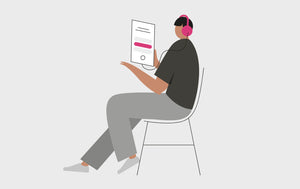Audiograms Explained
What Is An Audiogram?
Audiograms present our ability to hear plotted on a graph. You can obtain an audiogram by completing a hearing test. These graphed results reveal how well people responded to sounds and can be used to identify hearing loss.
There are a number of different diagnostic procedures and tests available to hearing healthcare professionals to measure hearing competency. Pure-tone audiometry is by far the most common method. This guide aims to help you understand hearing test results obtained from audiometry - these results are usually shown in the form of an audiogram.
Send Us Your Audiogram For Advice
If you would like to send us your audiogram, we would be delighted to review it with you, talk through what it may mean and of course, advise as to whether our range of hearing aids may be suitable.
Please click here to upload a copy of your audiogram and send it to us. Alternatively, you can scan it and email it to us at: customerservices@hearingdirect.com
How Audiogram Results Are Obtained
An audiogram graphically represents how individuals responded to a series of calibrated sounds which are produced by an audiometer; usually via headphones. The person being tested is asked to push a response button or raise their hand every time they think a sound is played.
Each ear is tested separately. The first aim of the test procedure is to determine the hearing thresholds for the different tones or frequencies. A threshold refers to the softest decibel level (volume) of a frequency required for a reliable response from the individual; i.e. the softest sound they are able to hear. The frequencies tested are within the range of 250Hz (low) through to 8000Hz (high). One of the main reasons for this is that this 250-8000Hz range covers the frequencies of human speech production. Some audiometers are however capable of producing much higher tones, but are not commonly used in standard audiometry.
Once the test is complete, the results get plotted onto a graph to reveal insights into our level of hearing. It is worth noting that some people with very similar audiograms can "hear" quite differently. While an audiogram can help explain much of the auditory behaviour of a person, it does not explain it all. There are other dimensions to auditory experiences that cannot be explained by the audiogram. Still, the audiogram is a good place to begin when trying to understand someone's hearing difficulties.
How To Read An Audiogram For Yourself
Your audiogram may look like this, where each ear is shown on a separate graph. This is an example of the right ear:

Or where both ears are combined into one graph, it can look like this:

First the fundamentals: Frequency (or pitch) is depicted on the horizontal axis, from low frequencies on the left (250 Hz) to high frequencies on the right (8000 Hz). The amount of hearing loss is shown on the vertical axis with the higher numbers indicating a greater degree of hearing loss. If the results are shown in colour, red is used for the right ear; and blue for the left.
The symbols used are circles for the right ear and crosses for the left. A mark on the graph thus shows a measure of the person’s hearing threshold at this frequency; i.e., the loudness (intensity) point where the sound is just audible. Thresholds from 0 to 20 dBHL (decibel Hearing Level) are considered to be within the normal hearing range for adults. After that point, people will usually begin to display some communication difficulties because of the elevated hearing thresholds. The higher the number, the greater the impact of the hearing loss.
It is important to be familiar with the details of your audiogram so changes over time may be tracked. Hearing loss, particularly adult-onset hearing losses, may get gradually worse (anybody experiencing rapid changes in their auditory thresholds should check with their GP as soon as possible).
How Does All Of This Work?
The circles and crosses for the right and left ears are referred to as air-conduction thresholds. They measure how an individual hears when the sound is presented via headphones or foam ear-inserts. The sound has travelled through the whole of the auditory system; from the air in/around the outer ear, through the middle ear and into the inner ear where it is transmitted to the brain via the nerve fibres. This determines the overall look of the audiogram.
In order to rule out any potential problems in the outer or middle ears, bone conduction testing may also be done as part of standard pure-tone audiometry. Here, the pure tones are not transmitted via headphones, but via a transducer that is put directly onto what is known as the mastoid bone – which is the bone you can feel just behind your ear. The inner ear is stimulated directly. The same frequencies are tested with the same procedure (respond to the softest level you can hear); and then plotted on the audiogram as bone-conduction results. If there is a significant difference between the air conduction and bone conduction results; it will alert the tester to a potential problem in the outer or middle ears. Bone conduction results are indicated by arrows or brackets on the audiogram.
Uncomfortable loudness testing may also be done as part of audiometry. This is to check a person’s range of hearing ability in terms of loudness. UCL or ULL measurements are indicated by the 'L' type symbols; and should occur towards the bottom of the audiogram. The difference between the thresholds and ULLs is referred to as the 'dynamic range' of hearing; and can be useful when a hearing aid is considered.
Once all the frequencies have been tested; a hearing loss, if present, can be described in terms of its degree; shape, and type.
Degrees Of Hearing Loss
The degree of loss is usually one of the following:
- Mild: thresholds between 20-39dB
- Moderate: 40-69dB
- Severe: 70-89dB
- Profound: 90dB+
The 100dB point should not be confused with a 100 percent hearing loss, (or a total lack of hearing). Hearing sensations do continue past this point, with some audiometers able to produce loudness levels up to 120dB.
Shapes Of Hearing Loss
The shape of hearing loss refers to the way the different thresholds follow on from each other. The audiogram in our example shows a sloping loss – meaning the thresholds gradually slope down as the frequencies get higher. Other terms could be:
- Flat: the amount of loss is fairly similar across the frequencies)
- Steeply sloping: the amount of loss changes dramatically from the low to high-frequency area
- Reverse slope: the loss is worse in the low frequencies, then recovers upwards as one moves to the high frequencies.
- Cookie-bite: (yes, really…): refers to an audiogram where the results are relatively good in the very low and very high frequencies, but not in the middle frequencies.
Types Of Hearing Loss
Type usually refers to the suggested cause of the hearing loss. This may be described as 'sensorineural' or 'conductive'.
Sensorineural implies the cause of the loss is due to damage within the inner ear – either the cochlea or nerve fibres. This is usually the case in age-related hearing loss.This condition is classed as a permanent hearing loss and it irreversible, often requiring digital hearing aids to properly manage the impairment. Conductive loss refers to the hearing loss being caused by a problem in the middle ear or outer ear (e.g. perforated ear drum or middle ear infection). 'Mixed' losses can be a combination of both conductive and sensorineural elements. E.g. where a person with age-related hearing loss has a perforated ear drum. Conductive hearing loss is more often temporary than a permanent affair.
If the ears are different in terms of degree; shape or type, they are described separately. If they are similar, the loss is usually referred to as 'bilateral'.
How To Effectively Manage Hearing Loss
Having completed hearing tests, visited hearing care professionals, and reviewed audiograms, you may need to take further action if hearing loss is present. The next steps may include hearing aids.
Digital hearing aids can bridge the gap between a hearing impairment and one's ability to enjoy the sounds they love. Many devices can be preprogrammed based on audiogram results so the hearing aid matches your hearing needs. Depending on the severity, certain instruments may be more valuable than others. For example, those with a more severe degree of loss may require more features on their device to manage their impairment. Alternatively, amplified phones and other extra loud items can help with the day-to-day antics and improve the quality of life for the hard of hearing.


